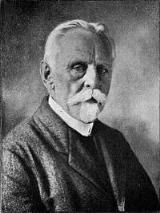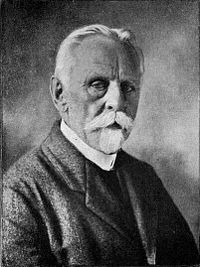
Jan Kubisz
Encyclopedia

Cieszyn Silesia
Cieszyn Silesia or Těšín Silesia or Teschen Silesia is a historical region in south-eastern Silesia, centered around the towns of Cieszyn and Český Těšín and bisected by the Olza River. Since 1920 it has been divided between Poland and Czechoslovakia, and later the Czech Republic...
. His poem Płyniesz Olzo po dolinie (You flow, Olza, down the valley), centered around the Olza River
Olza River
is a river in Poland and the Czech Republic, the right tributary of the Oder River. It flows from the Silesian Beskids through southern Cieszyn Silesia in Poland and Frýdek-Místek and Karviná districts of the Czech Republic, often forming the border with Poland. It flows into the Oder River north...
, became unofficial anthem of Cieszyn Silesia
Cieszyn Silesia
Cieszyn Silesia or Těšín Silesia or Teschen Silesia is a historical region in south-eastern Silesia, centered around the towns of Cieszyn and Český Těšín and bisected by the Olza River. Since 1920 it has been divided between Poland and Czechoslovakia, and later the Czech Republic...
, especially Poles in Zaolzie.
Biography
Jan Kubisz was born 24 January 1848 in KońskaKonská
Konská may refer to:* Konská, Czech Republic, village in Frýdek-Místek District, Czech Republic* Konská, Liptovský Mikuláš District, village in Liptovský Mikuláš District, Slovakia* Konská, Žilina District, village in Žilina District, Slovakia...
, Austrian Empire
Austrian Empire
The Austrian Empire was a modern era successor empire, which was centered on what is today's Austria and which officially lasted from 1804 to 1867. It was followed by the Empire of Austria-Hungary, whose proclamation was a diplomatic move that elevated Hungary's status within the Austrian Empire...
. Kubisz attended elementary school in Końska and Protestant gymnasium
Gymnasium (school)
A gymnasium is a type of school providing secondary education in some parts of Europe, comparable to English grammar schools or sixth form colleges and U.S. college preparatory high schools. The word γυμνάσιον was used in Ancient Greece, meaning a locality for both physical and intellectual...
in Cieszyn in 1860–1865 where he was taught in German
German language
German is a West Germanic language, related to and classified alongside English and Dutch. With an estimated 90 – 98 million native speakers, German is one of the world's major languages and is the most widely-spoken first language in the European Union....
since were no Polish-language high schools in the region at time of his youth. Kubisz later graduated from a teachers' seminary in Cieszyn and in 1869 began teaching at Polish school in Gnojnik at the age of 21. Kubisz lived at the school for the next 41 years. In 1910, Kubisz built his own house in the village, which remains an important landmark. During his work as a teacher, Kubisz remained active in several Polish organizations.
At the age of 20 in 1868, Kubisz published his first poem, which appeared in the Gwiazdka Cieszyńska
Gwiazdka Cieszynska
Gwiazdka Cieszyńska was a weekly Polish magazine published in Cieszyn in 1851-1939. After 1906 it appeared biweekly. It succeeded Tygodnik Cieszyński magazine which appeared in 1848-1851....
weekly magazine. In 1882, Kubisz published Niezapominajka under pen name
Pen name
A pen name, nom de plume, or literary double, is a pseudonym adopted by an author. A pen name may be used to make the author's name more distinctive, to disguise his or her gender, to distance an author from some or all of his or her works, to protect the author from retribution for his or her...
Szlązak. The Niezapominajka poetry collection focused mainly on national issues and glorified Cieszyn Silesia and customs of local people. In 1889 another poetry collection, Śpiewy starego Jakuba appeared. This collection focused on the social and national issues of his region. Poem Nad Olzą (On the Olza), later known as Płyniesz Olzo po dolinie (You flow, Olza, down the valley) which is a part of this collection later became unofficial anthem of Cieszyn Silesia
Cieszyn Silesia
Cieszyn Silesia or Těšín Silesia or Teschen Silesia is a historical region in south-eastern Silesia, centered around the towns of Cieszyn and Český Těšín and bisected by the Olza River. Since 1920 it has been divided between Poland and Czechoslovakia, and later the Czech Republic...
.
Kubisz also published his works in the Cieszyn press. In 1902 a large poetry book Z niwy śląskiej was published in Lwów thanks to Kubisz's friends. Kubisz's most acclaimed work, Pamiętnik starego nauczyciela (Diary of Old Teacher), was published in 1928 on the eve of Kubisz's life. The work describes the life and customs of the Cieszyn Silesia people at the end of 19th century and Kubisz's experiences as a teacher. Pamiętnik starego nauczyciela continues to be an important work used by historians, ethnographers and linguists.
Two years before Kubisz's death on 26 March 1929 in Gnojnik
Hnojník
is a village in Frýdek-Místek District, Moravian-Silesian Region, Czech Republic, on the Stonávka River. It has a population of 1,446 ; 11.5% of the population are Poles.- History :...
, Czechoslovakia
Czechoslovakia
Czechoslovakia or Czecho-Slovakia was a sovereign state in Central Europe which existed from October 1918, when it declared its independence from the Austro-Hungarian Empire, until 1992...
, Pastor Andrzej Buzek said of Kubisz:
Kubisz is remembered on both sides of Cieszyn Silesia. In Końska, there is a monument erected in 1968 in his birthplace. Another memorial, built in 1988, is located in Cieszyn
Cieszyn
Cieszyn is a border-town and the seat of Cieszyn County, Silesian Voivodeship, southern Poland. It has 36,109 inhabitants . Cieszyn lies on the Olza River, a tributary of the Oder river, opposite Český Těšín....
. There is also a street and a gymnasium
Gymnasium (school)
A gymnasium is a type of school providing secondary education in some parts of Europe, comparable to English grammar schools or sixth form colleges and U.S. college preparatory high schools. The word γυμνάσιον was used in Ancient Greece, meaning a locality for both physical and intellectual...
named after him in Cieszyn and Polish elementary school in Gnojnik is also named after Kubisz.
Works
- Niezapominajka (1882) — poetry collection
- Śpiewy starego Jakuba (1889) — poetry collection
- Z niwy śląskiej (1902) — poetry collection
- Pamiętnik starego nauczyciela (1928) — diary

